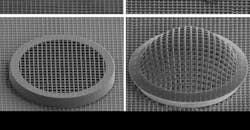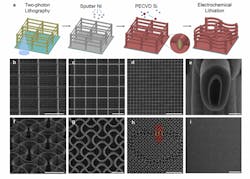Nanoparts that Change Shape and Hold It
Researchers in the labs at Georgia Institute of Technology have developed an “architected” material that transforms its structure almost immediately to change several physical properties. Alternately, it can transition smoothly between the properties of the first and second shapes.
Architected materials are comprised of micron and nanoscale structures such as crossbeams, arches, domes, and spirals, much like the elements of a building’s architecture. Researchers from the California Institute of Technology, the Georgia Institute of Technology, and ETH Zurich have concocted one that can be commanded to changes its shape. When a small current is applied, nanoscale beams thicken and bend into arches that increasingly bow as the current is boosted. The material maintains the new shape even when the current is off, and the shape can be changed back by reversing the current—two characteristics unique to this material.
A new architected material changes shape when a small current is applied and keeps that shape when the current is turned off. Reversing the current also reverses the direction of the change of the shape. The study was a collaboration between CalTech, Georgia Tech, and ETH Zurich.
Most materials that change their internal structure require a persistent external stimulus to remain in the new form. Georgia Tech’s new nanomaterial, however, deforms through an electrochemical silicon-lithium alloy reaction that holds its form without applied current.
“At the core of this accomplishment, you’re changing the geometry not by a little, which would be easy to do, but by a lot and variably, which is hard. And you’re doing it by electrochemistry that works the way a battery does,” says Claudio Di Leo, an assistant aerospace professor at Georgia Tech.
This special electron microscope view of changing architected material shows two structures of a new architected material change (upper and lower). Their shapes change when a low current is applied. (Left is before the current is applied; right is after.)
Di Leo’s team modeled the architectures’ nanoscale mechanics, which are driven by lithium ions and silicon, for research led by Julia Greer, a Caltech materials science professor. Her lab then created the material using an innovative ultra-high-resolution 3D printing process called two-photon lithography and tested it.
In the future, materials like this this could be used in making batteries and other energy storage devices lighter, safer, and more durable. Also, waves of phonons (special excitations in certain materials that help determine their conductivity) propagate through the material, but then shifts in architecture block those waves. While this was not the study’s main achievement, it is still a promising feature and possible opportunity for expanded research.



